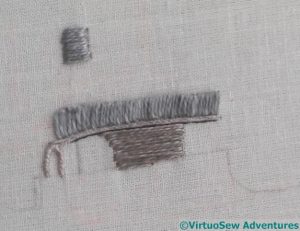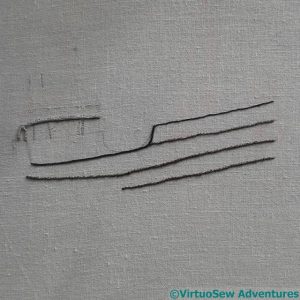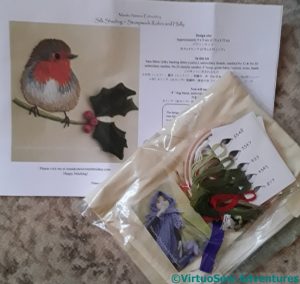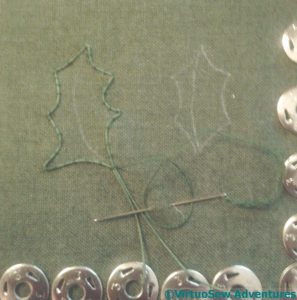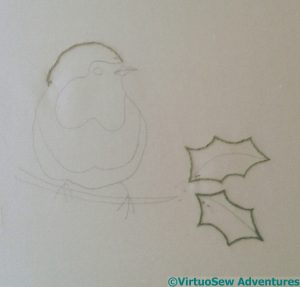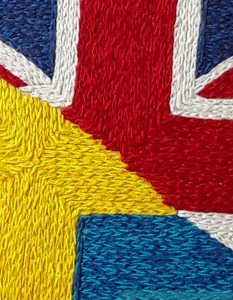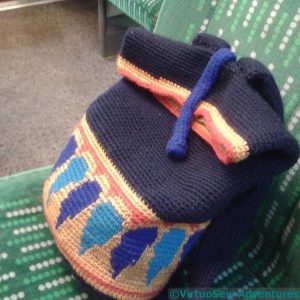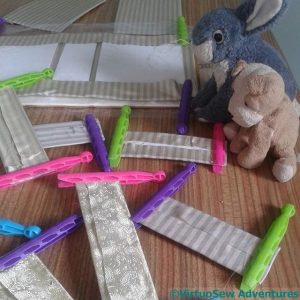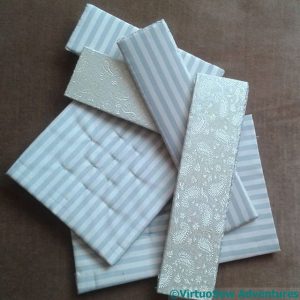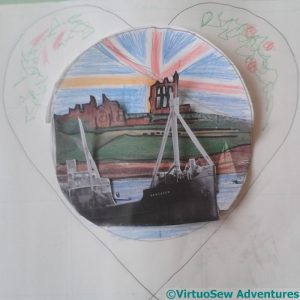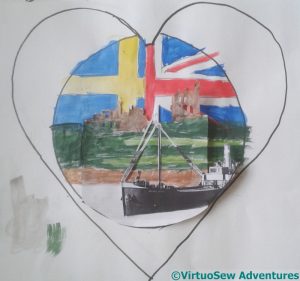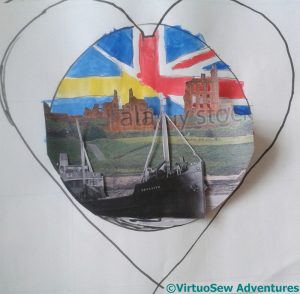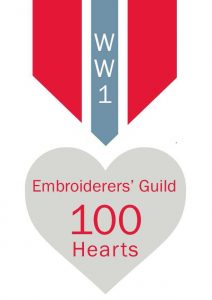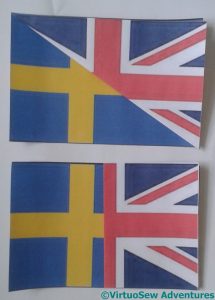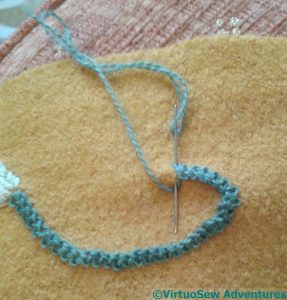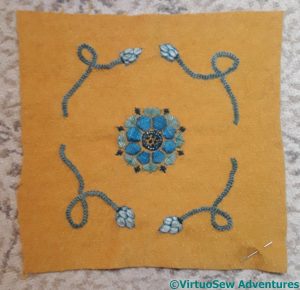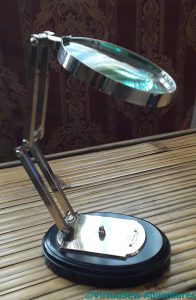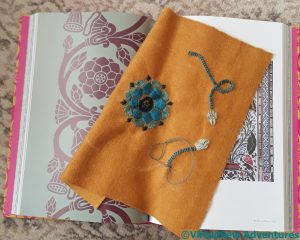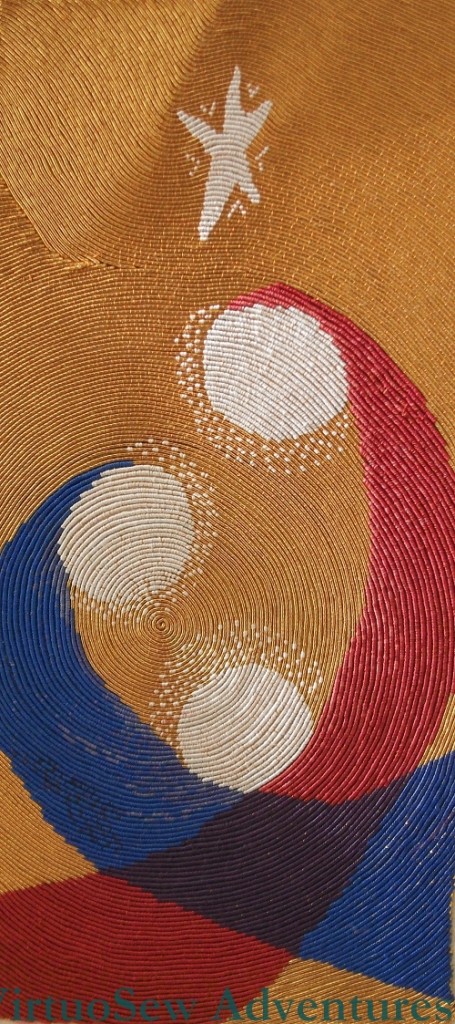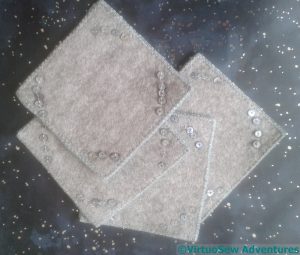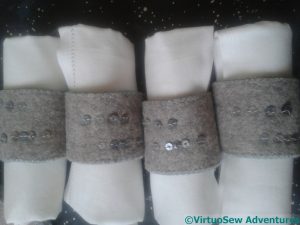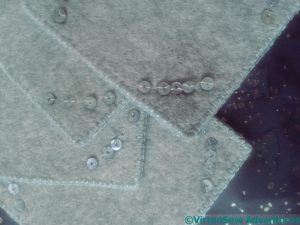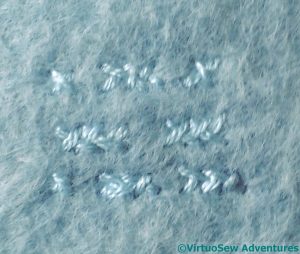Category: General Embroidery
Starting on the vessel for the 100 Hearts project
Having got the sunrise done, I thought I would have a go at the vessel.
Unfortunately, having made a start at the wheelhouse and crew quarters, I looked at what I’d done, growled, and snipped it out again. I don’t think the colours are right, and I know the textures aren’t.
*fumes*
So, off I went to “the pointy end” as my friends without benefit of sail training call it. That’s “the bows” to the rest of us…
The lines of stitching follow the shape of the hull, but I’ve used a twisted chain stitch, because I’m hoping it will help create an effect slightly reminiscent of rivets. The upper line of the gunwhales is in reverse chain stitch. This may prove to be a lower layer, helping to lift a line of gimp or padding above the base layer of stitching. I’m not sure yet about all the details!
The underlayer of stitching on the hull is in rows of surface satin stitch, using an overdyed stranded rayon yarn. As it stands, I like the colour variation – although I sincerely hope that even in time of war a vessel with that patched a hull would be kept in port – but I think it needs blending out a little.
I’m still working out how best to achieve that!
A Learning Opportunity
I’m a very lucky woman. Sometimes, as in this case, I have to say so through slightly gritted teeth…
In this case, I am expressing my good fortune in having a family that takes my embroidery as seriously as I do – and the gritted teeth are because my parents elected to give me a learning opportunity for Christmas.
Silk shading is something I know I should work at, but would be most unlikely to choose to do, because the naturalistic representation it tends to be used for is not really my forte.
All the more reason, of course, to make an attempt, at least, to get to grips with it, but I haven’t been able to convince myself to do so!
That said, Masako Newton‘s Silk Shading and Stumpwork Robin and Holly is really very sweet indeed, and I am sure I will enjoy working it.
Furthermore, unlike the Jane Rainbow kit my parents gave me for Christmas twenty years ago, there’s no chance of this one being finished quickly.
I will certainly learn a great deal from doing the Robin, and he is going to be classed as one of my New projects for 6 and 6 in 2018.
100 Hearts – The Flag Sunrise
I hope this is going to work as well in real life as it does in my imagination.
The flags provide good, bright, heraldic colours (of course) and I am hoping that I have done a large enough area to create the Roundel in the manner that I have “seen”.
This section has been embroidered on a piece of calico I had conveniently to hand, using Danish Flower Thread, which is not at all shiny. That will help the sunrise to settle back behind the other elements. I’ve used closely-set rows of chain stitch and reverse chain stitch alternately, so as to keep the stitches facing the same way while minimising the number of ends that need to be finished off.
I’ve used two slightly different shades in the needle for each colour. That helped me to get the colours as accurate as I could while keeping within the colour range I had to choose from. In the case of the blues, I used three shades only – the middle shade appears as the darker one in the Swedish section and the lighter one in the British section. I’m very pleased with how that worked, as the two very different blues live very happily together here.
Report for “6 and 6 in 2018”
When I read the post on Meredithe’s blog for the March round up of the “6 and 6 in 2018” project, I thought maybe I should do my own. More especially, as I do indeed have progress to report!
One definite advance this year is that the Amarna backpack is finished. After the straps were attached, it had a very brief trial outing. After which, I decided it needed a lining (a lovely sandy coloured printed cotton) and a zip. The zip was something of a struggle to install, but I managed in the end, and the backpack had its first real outing when I took it with me to “Sewing for Pleasure” in Birmingham.
I’ve started to make progress on Eve in the Garden of Eden as well. Regular readers know that I’m very uncomfortable with using glue near fabric – or indeed, at all! However, my friends Small Rachel and Harry The Hound of the Doleful Countenance came to supervise and encourage, and remind me to take it slow and steady.
And the reminders paid off. The glueing is done, and the next phase involves quite a lot of sewing. The box sides are made of an outer and an inner, and while each of those is glued on the back, in the case of the lining over some padding, the outer and the inner are sewn together.
Again, this is happening bit by bit. It’s concentrated and fiddly work, and I couldn’t yet sit down and expect to finish it in a sitting.
But the glueing is done!
As for new projects, so far there is the cover for Maggie the Magnifier, a Learning Opportunity, and of course the Embroiderers Guild 100 Hearts piece.
So watch this space, there will be more!
Designing my “100 Hearts” piece
I found some pictures of Tynemouth Priory online to help me draft my design, and then went rummaging for pictures of vessels built on the Tyne that were in service at the time of the war.
Of course this is all entirely speculative; we have found Great Grandfather on a crew list of 1915, but unfortunately so far we haven’t found any images of the ship. His crewmates include many local lads, of course, but also Danes, Finns, a Russian, and even other Swedes. There must be so many untold stories there…
In the first draft, I was still working on the idea of the gold cross being like the St George’s cross, and I was very disappointed that the Swedish flag almost seemed to vanish.
In the second, I corrected that misapprehension, trialled a vertical rather than diagonal division, and used a different vessel, this one slightly smaller and coming inward rather than departing.
I’ve also moved the Priory to the right a little so that there is rather more of a sense of balance.
In the third draft, I reinstated the diagonal, left the Priory shifted rightwards, and returned to the first vessel. I’ve also slightly enlarged the Priory.
As I look at these, I find myself thinking that the design rather resembles naval ship badges, so perhaps what I need to do is to shrink the whole design a little, tweak it a little more, and edge the circle with a wreath or rope motif.
So I’ve not finished thinking yet!
The Embroiderers Guild “100 Hearts” project
I am now a member of The Embroiderers Guild, and when my membership card arrived, so did some information about a project they are doing in collaboration with SSAFA, called “100 Hearts”. It offers embroiderers and textile artists the opportunity to create their own memorial to all those who fought and died or came back changed, to all those who kept the home fires burning, and, in summary, to all the many untold stories of that time.
Now, generally speaking I’m not very good at responding to a brief I’ve not created myself, but as I sat reading the information and pondering whether to join in, I thought about my Grandmama, who taught me to embroider, but who would probably be bemused and (I hope) impressed in equal measure by what I have done with what she taught me. Her father was a Swedish immigrant to the UK, who became a British citizen shortly after her birth. He won’t have been a young man when the war broke out, and I’m sure he wasn’t called up, but he was a mariner, and I expect that he was working in coasting freighters, keeping the supply of food and fuel moving. From that I thought that he could stand for the many immigrants and naturalised citizens who, in the face of the hysteria and suspicion of the time, continued to serve their adopted home loyally and well.
So my design will be specific and local – he lived in South Shields, and I’m using the headland and the shape of Tynemouth Priory to stand for that – but it stands for much, much more than that.
I will be searching to see what more I can find out, about Great Grandfather, about what he might have been doing, and about what records there may be concerning the war service of immigrants and naturalised citizens, and we will see what I manage to come up with!
To begin with, I want Tynemouth Priory to be set against a “sunset” of the two flags of Sweden and the United Kingdom. I had originally misremembered that the gold cross on the Swedish flag was essentially the same as the cross of St George, but no, the vertical line is set closer to the hoist (the part of the flag nearest the flagpole).
Once I’ve decided how large my sunset needs to be, I can start stitching it while I go to have a look at Tynemouth priory….
More on the cover for the magnifier
The embroidery on the new cover for Maggie The Magnifier is relatively simple, but it does involve a few favourite stitches.
First and foremost, Braid Stitch. Not the Infamous Plaited Braid Stitch – I was sure I wouldn’t have enough wool for that! – but the ordinary Braid Stitch. I’ve been fond of it for years, as it makes a good, strongly textured line, and it’s much easier than it looks. It’s also fairly easy to work in the hand, and this was very much a holiday period project, using bits and pieces I could easily get hold of, which didn’t include my embroidery hoops!
The central rosette uses satin stitch (not a favourite, exactly, but very effective!), Romanian Stitch, and in the centre, a little knotted stitch that I’m sure I know from a book, and has a name, but it just came swimming up out of my head, unattributed, as though I was making it up as I went along.
The buds, or finials, or whatever they are, are in nested fly stitches, outlined with further fly stitches, and you will note, from this view, that I stuck to my decision to draft the design by hand, and not tweak and even it up. This is very much a piece of domestic, informal embroidery, and there’s no reason for it to look glossy and machine made.
Cover for my new magnifier
Meet Maggie the Magnifier, so called to distinguish her from Jenny the Jensen Magnifier Light. Maggie was a Christmas present from my cousin. She’s wonderfully sturdy, with a nice heavy base, and notwithstanding the base mentions 1815, we think that was the foundation of the company, and Maggie herself is probably from the 1920s. She will be very useful for details and work at the table, rather than at my embroidery frame, but she needs a cover, both to keep the dust off, and to stop her setting fire to things on those rare occasions when the sun comes out.
Making the cover seemed a good way to pass the time over the period when I had Akhenaten hidden away, so I used a piece of brushed bouclé fabric and some rather lovely wool thread I got from somewhere-but-I-can’t-remember-where.
Since I did the Great Lady’s Magazine Stitch Off, I’ve become very conscious of what I learnt that I didn’t anticipate – becoming aware of how much more often an embroiderer of that period would have reckoned that Close Enough Is Good Enough, how often a pattern would have been sketched on by eye, rather than prick-&-pounced for precision, how much effect and speed would have trumped detail. I’m trying to apply that myself – when I don’t need exactitude, I don’t intend to strive for it. I hope it will make fun new projects more fun, and more “free”. This is a perfect candidate for that approach.
The basis of the design is a floral pattern from a rather gorgeous book called “Pattern and Ornament in the Arts of India”, with curlicues in the corners of the square of fabric. I practiced a couple of times in a notebook, and then simply drew the design in chalk on the fabric and started stitching.
This is going to be one of my New projects for this year…
A Happy Christmas to you all
A Happy Christmas to you all!
No Work in Progress this week, just very best wishes to everyone for a peaceful and happy Christmas and a creative 2018!
A Wedding Gift
It pays to be as organised as possible when you are dealing with weddings, but I’ve not been very organised in general this year. That said, not knowing what sort of things our friends’ combined taste would run to until two months before the wedding was rather a handicap. In the end, we bought something from the list and then I decided to do a little something extra.
I’ve made a set of coasters and napkin rings in felt, in colours that should work with the crockery they’ve chosen, although they aren’t the same. The two layers of felt are bonded and then blanket stitched together using a vintage silk thread that just happened to work rather well.
And the embellishment is made using tiny sequin-like beads made of shell.
And what is the embellishment, I hear you ask? What else, I hear myself reply, but the initials of our friends’ given names in Morse Code. Fortunately the letters in question are both symmetrical and palindromic, so they work in whatever orientation they are placed. The coasters have each initial twice, in opposite corners, and the napkin rings once each.
As old friends, they know of my proclivities for using Morse Code, so, lest they be disappointed, I have signed each coaster on the back with my initials in Morse Code.

